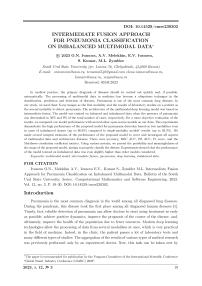Intermediate fusion approach for pneumonia classification on imbalanced multimodal data
Автор: Ivanova O.N., Melekhin A.V., Ivanova E.V., Kumar S., Zymbler M.L.
Статья в выпуске: 3 т.12, 2023 года.
Бесплатный доступ
In medical practice, the primary diagnosis of diseases should be carried out quickly and, if possible, automatically. The processing of multimodal data in medicine has become a ubiquitous technique in the classification, prediction and detection of diseases. Pneumonia is one of the most common lung diseases. In our study, we used chest X-ray images as the first modality and the results of laboratory studies on a patient as the second modality to detect pneumonia. The architecture of the multimodal deep learning model was based on intermediate fusion. The model was trained on balanced and imbalanced data when the presence of pneumonia was determined in 50% and 9% of the total number of cases, respectively. For a more objective evaluation of the results, we compared our model performance with several other open-source models on our data. The experiments demonstrate the high performance of the proposed model for pneumonia detection based on two modalities even in cases of imbalanced classes (up to 96.6%) compared to single-modality models’ results (up to 93.5%). We made several integral estimates of the performance of the proposed model to cover and investigate all aspects of multimodal data and architecture features. There were accuracy, ROC AUC, PR AUC, F1 score, and the Matthews correlation coefficient metrics. Using various metrics, we proved the possibility and meaningfulness of the usage of the proposed model, aiming to properly classify the disease. Experiments showed that the performance of the model trained on imbalanced data was even slightly higher than other models considered.
Multimodal model, intermediate fusion, pneumonia, deep learning, imbalanced data
Короткий адрес: https://sciup.org/147241251
IDR: 147241251 | УДК: 004.891.3 | DOI: 10.14529/cmse230302
Список литературы Intermediate fusion approach for pneumonia classification on imbalanced multimodal data
- COVID-19 and vascular disease // EBioMedicine. 2020. Aug. Vol. 58. P. 102966. DOI: 10.1016/j.ebiom.2020.102966.
- Soenksen L.R., Ma Y., Zeng C., et al. Code for generating the HAIM multimodal dataset of MIMIC-IV clinical data and x-rays. 2022. DOI: 10.13026/3F8D-QE93.
- Qiu S., Chang G.H., Panagia M., et al. Fusion of deep learning models of MRI scans, Mini–Mental State Examination, and logical memory test enhances diagnosis of mild cognitive impairment // Alzheimer’s & Dementia: Diagnosis, Assessment & Disease Monitoring. 2018. Jan. Vol. 10, no. 1. P. 737–749. DOI: 10.1016/j.dadm.2018.08.013.
- Parcalabescu L., Frank A. MM-SHAP: A Performance-agnostic Metric for Measuring Multimodal Contributions in Vision and Language Models Tasks. 2022. DOI: 10.48550/ARXIV.2212.08158.
- Bakalos N., Voulodimos A., Doulamis N., et al. Fusing RGB and Thermal Imagery with Channel State Information for Abnormal Activity Detection Using Multimodal Bidirectional LSTM // Cyber-Physical Security for Critical Infrastructures Protection. Springer International Publishing, 2021. P. 77–86. DOI: 10.1007/978-3-030-69781-5_6.
- Sarada N., Rao K.T. A Neural Network Architecture Using Separable Neural Networks for the Identification of “Pneumonia” in Digital Chest Radiographs // International Journal of e-Collaboration. 2021. Jan. Vol. 17, no. 1. P. 89–100. DOI: 10.4018/ijec.2021010106.
- Vashisht S., Sharma B., Lamba S. Using Support Vector Machine and Generative Adversarial Network for Multi-Classification of Pneumonia Disease // 2023 4th International Conference for Emerging Technology (INCET). IEEE, May 2023. DOI: 10.1109/incet57972.2023.10170180.
- Yadav P., Menon N., Ravi V., Vishvanathan S. Lung-GANs: Unsupervised Representation Learning for Lung Disease Classification Using Chest CT and X-Ray Images // IEEE Transactions on Engineering Management. 2023. Aug. Vol. 70, no. 8. P. 2774–2786. DOI: 10.1109/tem.2021.3103334.
- Fang M., Peng S., Liang Y., et al. A Multimodal Fusion Model with Multi-Level Attention Mechanism for Depression Detection // SSRN Electronic Journal. 2022. DOI: 10.2139/ssrn.4102839.
- Cai S., Wakaki R., Nobuhara S., Nishino K. RGB Road Scene Material Segmentation // Computer Vision – ACCV 2022. Springer Nature Switzerland, 2023. P. 256–272. DOI: 10.1007/978-3-031-26284-5_16.
- Msuya H., Maiseli B.J. Deep Learning Model Compression Techniques: Advances, Opportunities, and Perspective // Tanzania Journal of Engineering and Technology. 2023. June. Vol. 42, no. 2. P. 65–83. DOI: 10.52339/tjet.v42i2.853.
- Pereira R.M., Costa Y.M., Jr. C.N.S. MLTL: A multi-label approach for the Tomek Link undersampling algorithm // Neurocomputing. 2020. Mar. Vol. 383. P. 95–105. DOI: 10.1016/j.neucom.2019.11.076.
- Tang B., He H., Zhang S. MCENN: A variant of extended nearest neighbor method for pattern recognition // Pattern Recognition Letters. 2020. May. Vol. 133. P. 116–122. DOI: 10.1016/j.patrec.2020.01.015.
- Xin L., Mou T. Research on the Application of Multimodal-Based Machine Learning Algorithms to Water Quality Classification // Wireless Communications and Mobile Computing / ed. by C.-H. Wu. 2022. July. Vol. 2022. P. 1–13. DOI: 10.1155/2022/9555790.
- Aridas C.K., Karlos S., Kanas V.G., et al. Uncertainty Based Under-Sampling for Learning Naive Bayes Classifiers Under Imbalanced Data Sets // IEEE Access. 2020. Vol. 8. P. 2122–2133. DOI: 10.1109/access.2019.2961784.
- Li Y., Branco P., Zhang H. Imbalanced Multimodal Attention-Based System for Multiclass House Price Prediction // Mathematics. 2022. Dec. Vol. 11, no. 1. P. 113. DOI: 10.3390/math11010113.
- Mathew R.M., Gunasundari R. An Oversampling Mechanism for Multimajority Datasets using SMOTE and Darwinian Particle Swarm Optimisation // International Journal on Recent and Innovation Trends in Computing and Communication. 2023. Mar. Vol. 11, no. 2. P. 143–153. DOI: 10.17762/ijritcc.v11i2.6139.
- Chawla N.V., Bowyer K.W., Hall L.O., Kegelmeyer W.P. SMOTE: Synthetic Minority Over-sampling Technique // J. Artif. Intell. Res. 2002. Vol. 16. P. 321–357. DOI: 10.1613/jair.953.
- Siriseriwan W., Sinapiromsaran K. Adaptive neighbor synthetic minority oversampling technique under 1NN outcast handling // Songklanakarin Journal of Science and Technology (SJST). 2017. Vol. 39. P. 5. DOI: 10.14456/SJST-PSU.2017.70.
- Alhudhaif A. A novel multi-class imbalanced EEG signals classification based on the adaptive synthetic sampling (ADASYN) approach // PeerJ Computer Science. 2021. May. Vol. 7. P. 523. DOI: 10.7717/peerj-cs.523.
- He H., Bai Y., Garcia E.A., Li S. ADASYN: Adaptive synthetic sampling approach for imbalanced learning // Proceedings of the International Joint Conference on Neural Networks, IJCNN 2008, part of the IEEE World Congress on Computational Intelligence, WCCI 2008, Hong Kong, China, June 1-6, 2008. IEEE, 2008. P. 1322–1328. DOI: 10.1109/IJCNN.2008.4633969.


